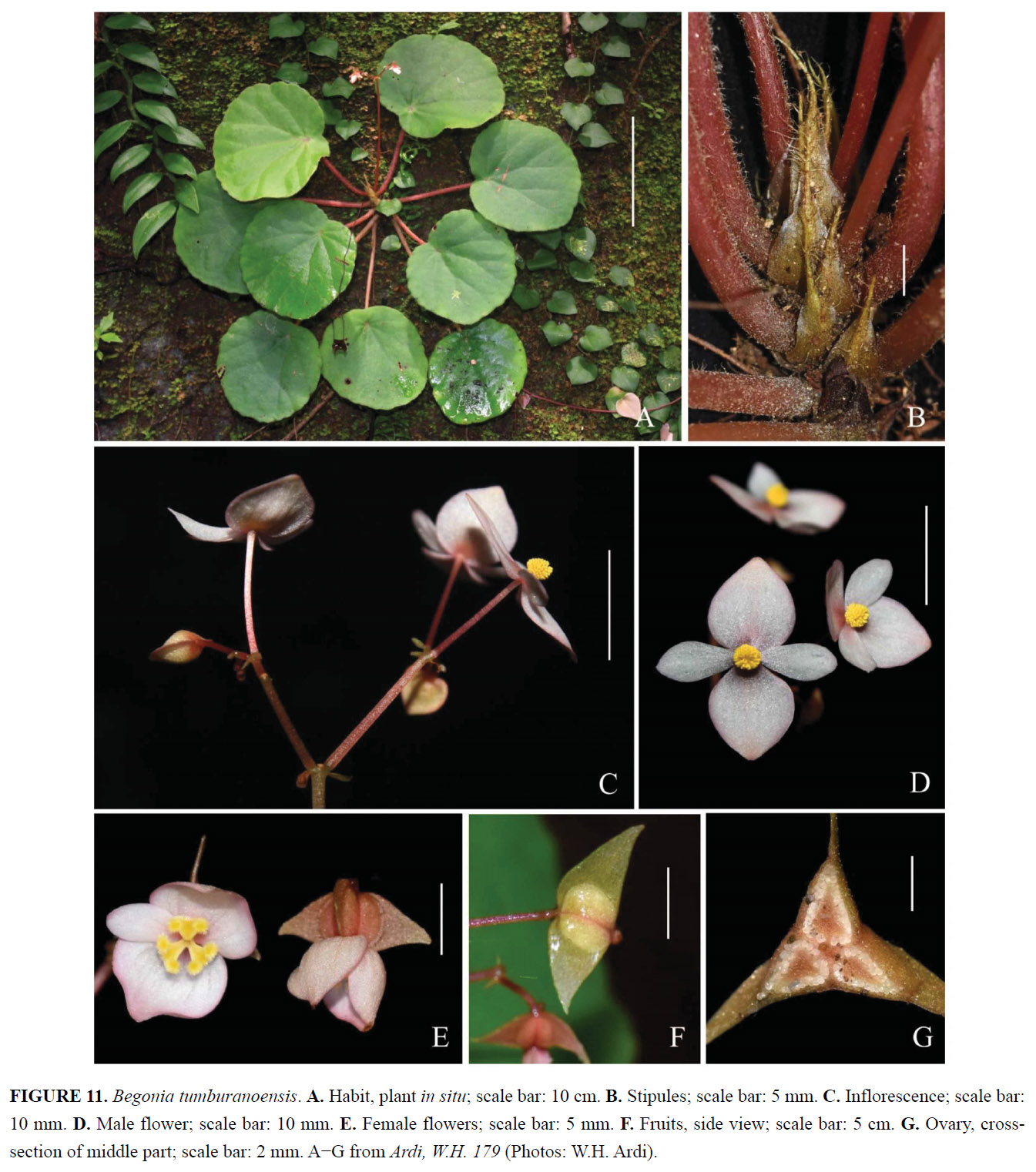Begonia tumburanoensis in Phytotaxa 381(1): 45. 2018
Primary tabs

Diagnosis
- Similar to Begonia coriacea Hasskarl (1844: 192) but differs by its compressed internodes (up to 3 mm vs 5–15 mm), smaller leaves (4.5–10 × 4.4–9.9 cm) with crenate margin (vs 16–24 × 3–23 cm, margin dentate), male flowers with an androecium of ca. 59–61 stamens (vs 44–46 stamens); female flowers with three tepals (vs four tepals), and ovary wings that are pointed at the widest point (vs. rounded). (Ardi, W.H., Chikmawati, T., Witono, J.R. & Thomas, D.C. (2018). A synopsis of Begonia (Begoniaceae) of Southeastern Sulawesi including four new species. Phytotaxa 381.1: 027-050.)
Description
- Perennial, lithophytic, monoecious herb, up to 25 cm tall. Stem rhizomatous, up to 8 cm long, internodes compressed, up to 3 mm long. Stipules persistent, ovate, 5.5–11 × 5–7.5 mm, asymmetric, with abaxially prominent midrib, apex narrowed into bristle projecting up to 3 mm, hairy. Leaves: alternate; petioles 5.5–21.5 cm long, reddish to brownish, terete, hairy, hairs ca. 1 mm long; lamina peltate, 4.5–10 × 4.4–9.9 cm, suborbicular to broadly ovate, coriaceous, margin crenate, ciliate and with recurved stiff teeth at the end of the veins, apex obtuse, adaxially green, flat, glabrous, abaxially pale green with sparse hairs on veins only; venation palmate, primary veins 6–8, actinodromous, secondary veins craspedodromous. Inflorescences protandrous, bisexual, axillary, dichasial cymes branching two times; peduncles 2.5–12 cm long, glabrous; bracts ca. 3 × 1.5 mm, elliptic, persistent. Male flowers pedicels 5–12 mm long, glabrous; tepals 4, unequal, white tinged pink, two outer tepals 7–11.5 × 7.5–10 mm, obovate to broadly ovate, slightly cordate at the base becoming truncate when flowers open, margin entire, apex obtuse, outer surface glabrous, inner tepals 4.5–9.5 × 3–4.5 mm, obovate, apex rounded to slightly emarginate; androecium yellow, symmetric, globose, on a ca. 1 mm long column; stamens ca. 59–61, filaments up to ca. 0.5 mm long, anthers up to ca. 1 mm long, dehiscing through laterally positioned slits more than half the anthers length. Female flowers pedicels 8–11 mm long; tepals 3, unequal, white tinged pink, 2 outer tepals 6.5–7 × 6.5–8 mm, broadly ovate, slightly cordate at the base becoming truncate when open, margin entire, apex obtuse, one inner tepal ca. 4.5–5 × 2.5–3 mm, base cuneate, margin entire, apex rounded; ovary (excluded wings) 3–4 × 4–4.5 mm, subgloboid, reddish, glabrous, wings 3, subequal, base rounded, apex concave–convex to subtruncate, widest point (apically or subapically) up to 3.5 mm; style ca. 2.5 mm long, basally fused, 3–branched, each stylodium bifurcate in the stigmatic region, stigmatic surface a spirally twisted papillose band, orange. Fruits: peduncles of infructescence 8–12 cmlong; pedicels 8–14 mm long, slightly recurved; seed-bearing part globoid, 4–4.5 × 4–5 cm (excluding wings), wings 3, subequal, shape as for ovary, widest point (at the apex or subapically) up to 7 mm. Seeds barrel-shaped, ca. 0.2 mm long. (Ardi, W.H., Chikmawati, T., Witono, J.R. & Thomas, D.C. (2018). A synopsis of Begonia (Begoniaceae) of Southeastern Sulawesi including four new species. Phytotaxa 381.1: 027-050.)
Habitat
- Moist vertical limestone rock or in forest on steep slopes of waterfall embankment, with Cyrtandra, aroids and ferns at 200 m elevation.
Conservation
- Critically Endangered CR B2ab(iii). Begonia tumburanoensis is known from only two locations (Tumburano Waterfall and Tanjung Peropa Forest Reserve) and only small population sizes were observed. The type locality is a popular tourist destination on Wawonii Island. The forest around the waterfall has no legal status as protected area and potential threats were observed (tourism, as well as coconut and cacao plantations) in the area. Wawonii is very poorly explored, and this species it likely to have a wider range on the island as well as in the Tanjung Peropa Forest Reserve. However, even if this is the case, the extend of suitable karst habitats is still very limited, and its EOO and AOO would still fall well in the range for a Critically Endangered status. (Ardi, W.H., Chikmawati, T., Witono, J.R. & Thomas, D.C. (2018). A synopsis of Begonia (Begoniaceae) of Southeastern Sulawesi including four new species. Phytotaxa 381.1: 027-050.)
Distribution (General)
- Indonesia; endemic to Sulawesi, Southeast Sulawesi (Wawonii Island and Tanjung Peropa). (Ardi, W.H., Chikmawati, T., Witono, J.R. & Thomas, D.C. (2018). A synopsis of Begonia (Begoniaceae) of Southeastern Sulawesi including four new species. Phytotaxa 381.1: 027-050.)A
Etymology
- The epithet refers to the locality where the species was discovered and collected: Tumburano Waterfall, Wawonii island. (Ardi, W.H., Chikmawati, T., Witono, J.R. & Thomas, D.C. (2018). A synopsis of Begonia (Begoniaceae) of Southeastern Sulawesi including four new species. Phytotaxa 381.1: 027-050.)B
Notes
- Peltate leaves are a common character in section Jackia and there are at least 11 Malesian species known to have peltate leaves (see Brown 1882, Jansson 1963, Kiew 2005, Girmansyah 2009, Kiew & Sang 2009, Hughes et al. 2015a). Among these, Begonia coriacea from Sumatra, Java and Bali is morphologically similar to B. tumburanoensis, but it can be differentiated by a suite of characters (see diagnosis above). Begonia karangputihensis M.Hughes (2015:17) shows some similarities in having peltate leaves. However, apart from that, the two species are morphologically dissimilar, and longer petioles (up to 21.5 cm), suborbicular to broadly ovate leaves with a crenate margin and hairy on the abaxial venation, smaller and persistent bracts (3 × 1.5 mm), shorter peduncles (2.5–12 mm) and female flower pedicels (8–11 mm) separate Begonia tumburanoensis from B. karangputihensis, which has shorter petioles (up to 15 cm), broadly ovate to elliptic leaves with dentate margin, which are abaxially glabrous, larger and caducous bracts (5 × 4 mm), longer peduncles (12.5–17 mm) and female flower pedicels (10–15 mm long). (Ardi, W.H., Chikmawati, T., Witono, J.R. & Thomas, D.C. (2018). A synopsis of Begonia (Begoniaceae) of Southeastern Sulawesi including four new species. Phytotaxa 381.1: 027-050.)

